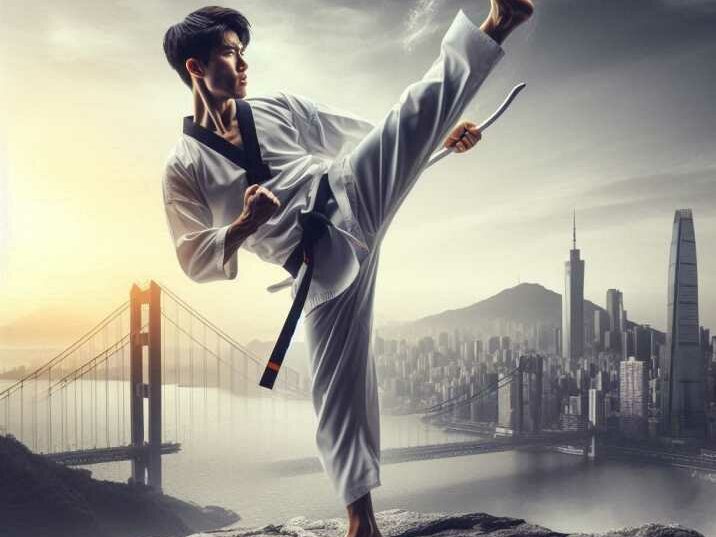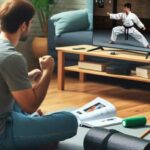Learning a martial art can be an exciting and rewarding experience. But if you’re just starting out, you might wonder which martial art is the easiest to learn. This guide explores the easiest martial arts for beginners, considering factors like simplicity, learning curve, and accessibility.
Introduction
Table of Contents
Martial arts are not only about fighting; they also teach discipline, respect, and self-improvement. For beginners, choosing the right martial art is essential to ensure a positive experience and steady progress. In this article, we will look at the easiest martial arts to learn, focusing on those that are beginner-friendly and offer a straightforward learning process.
1. Taekwondo
Overview
Taekwondo is a martial art originating from Korea, renowned for its dynamic high kicks and swift footwork. It focuses on a variety of kicks, including jumping and spinning kicks, which make the art visually striking and engaging. Taekwondo’s emphasis on fast, high-impact movements not only makes it an exciting martial art to practice but also a highly effective one for improving agility and coordination.

Why It’s Easy to Learn
Structured Classes:
Taekwondo classes are designed with a clear, step-by-step progression. Beginners start with fundamental techniques such as basic stances and simple kicks. As practitioners advance, they gradually learn more complex techniques and combinations. This structured approach helps beginners build a strong foundation before moving on to more advanced skills, making the learning process less overwhelming.
Simple Techniques:
The basic techniques in Taekwondo are relatively straightforward. For instance, foundational kicks like the front kick and side kick are easy to grasp and practice. These simple techniques are essential building blocks, allowing beginners to focus on perfecting their form and technique before tackling more advanced moves. This simplicity makes Taekwondo accessible to new students, regardless of their prior martial arts experience.
Benefits
Improves Flexibility:
One of the most notable benefits of Taekwondo is its emphasis on high kicks and dynamic movements. Regular practice of these techniques significantly enhances flexibility, particularly in the legs and hips. Improved flexibility not only aids in executing Taekwondo techniques but also contributes to overall physical health and injury prevention.
Boosts Physical Fitness:
Taekwondo is an excellent full-body workout. The practice involves a combination of kicking, punching, and footwork drills, which help improve cardiovascular fitness, strength, and endurance. Engaging in Taekwondo regularly provides a comprehensive physical exercise routine that benefits overall fitness and helps in maintaining a healthy weight.
Ideal For
Beginners looking to improve their flexibility and physical fitness while learning a traditional martial art:
Taekwondo is well-suited for beginners who want to start a martial art that offers both physical and mental benefits. It’s ideal for those interested in improving their flexibility, enhancing physical fitness, and learning a respected traditional martial art. The structured classes and simple techniques make it easier for newcomers to grasp and enjoy their training, making Taekwondo a great choice for anyone starting their martial arts journey.
2. Karate
Overview
Karate is a traditional Japanese martial art that emphasizes striking techniques. It involves a variety of powerful movements including punches, kicks, and knee strikes. Karate practitioners use these strikes to both attack and defend. The martial art also incorporates blocking techniques to protect against incoming attacks. The practice of Karate is not only about physical strikes but also involves developing mental focus, discipline, and respect.
Why It’s Easy to Learn
Basic Techniques:
Karate starts with fundamental techniques that are relatively easy to learn and apply. For instance, beginners typically begin with basic punches, kicks, and stances. These foundational techniques are straightforward and allow practitioners to quickly gain a grasp of the essential movements. As students become more comfortable with these basics, they gradually move on to more advanced techniques and combinations.
Clear Progression:
Karate uses a structured belt system to signify different levels of proficiency. Beginners start with a white belt and progress through various colored belts as they advance. This clear progression system helps students track their progress and stay motivated. Each belt level represents a new set of skills and knowledge, providing a tangible sense of achievement and encouraging continuous improvement.
Benefits
Improves Strength:
Regular practice of Karate helps build both physical strength and endurance. The martial art involves various drills and techniques that engage different muscle groups, contributing to overall muscle development. Strength is developed through striking techniques, conditioning exercises, and the repetitive practice of movements.
Teaches Discipline:
Karate is known for its emphasis on discipline and respect. Practicing Karate involves adhering to a set of rules and principles, both in the dojo (training hall) and in daily life. Students learn to respect their instructors, fellow practitioners, and the martial art itself. This focus on discipline helps foster a strong work ethic and promotes self-control and respect, which are valuable traits both inside and outside the dojo.
Ideal For
Beginners interested in a traditional martial art that focuses on striking and self-defense:
Karate is an excellent choice for beginners who want to learn a traditional martial art that emphasizes striking techniques and self-defense. Its straightforward techniques and structured progression make it accessible for new students. Those interested in gaining physical fitness, learning self-defense, and developing personal discipline will find Karate to be a fulfilling martial art to start with.
3. Jiu-Jitsu
Overview
Jiu-Jitsu is a Brazilian martial art that emphasizes ground fighting and submission techniques. Unlike striking-based martial arts, Jiu-Jitsu focuses on using leverage, technique, and positioning to control and submit an opponent. It’s designed to allow a smaller or weaker person to effectively defend themselves against a larger or stronger adversary. Jiu-Jitsu practitioners often engage in grappling and submission holds, making it unique among martial arts.
Why It’s Easy to Learn
Practical Techniques:
Jiu-Jitsu techniques are highly practical and applicable in real-life situations. The martial art teaches moves such as joint locks, chokes, and positional controls that can be used effectively in self-defense scenarios. The emphasis on technique over strength makes it accessible to beginners, as the focus is on learning how to use one’s body efficiently rather than relying on physical power. This practicality ensures that students can quickly grasp the fundamental concepts and apply them in realistic situations.
Controlled Environment:
Training in Jiu-Jitsu often takes place in a controlled environment where students practice techniques with a partner under supervision. This setup allows for safe experimentation and learning, as practitioners can practice moves and techniques without the risk of serious injury. The controlled environment also provides opportunities for immediate feedback from instructors, helping students refine their techniques and understand the principles behind them.
Benefits
Improves Grappling Skills:
One of the main benefits of Jiu-Jitsu is its focus on grappling and submission skills. Practitioners develop strong grappling abilities, which are crucial for controlling and submitting opponents on the ground. This skill set is not only useful in martial arts competitions but also in real-world self-defense situations where close-quarters combat may occur.
Enhances Problem-Solving:
Jiu-Jitsu teaches strategic thinking and problem-solving. During training, practitioners must constantly adapt their techniques and strategies based on their opponent’s movements and actions. This dynamic problem-solving aspect of Jiu-Jitsu helps students improve their critical thinking and decision-making skills, both in and out of the dojo.
Ideal For
Beginners who are interested in ground fighting and submissions:
Jiu-Jitsu is particularly well-suited for beginners who are interested in ground fighting and submission techniques. Its focus on technique and leverage makes it accessible to new students, even if they do not have a background in martial arts or physical strength. Those who enjoy grappling and want to learn effective self-defense techniques will find Jiu-Jitsu to be a rewarding martial art to start with.
4. Boxing
Overview
Boxing is a straightforward martial art that focuses primarily on punching techniques and footwork. Known for its rigorous cardiovascular training and emphasis on quick reflexes, boxing is a popular sport and martial art that helps improve overall fitness and defensive skills. The sport combines powerful punches with agile footwork to create an effective and dynamic fighting style.
Why It’s Easy to Learn
Simple Techniques:
Boxing techniques are relatively simple and easy to grasp. Basic movements such as jabs, crosses, hooks, and uppercuts form the foundation of boxing. These fundamental techniques are straightforward to learn and practice, allowing beginners to quickly get a handle on the basics. Unlike some martial arts that involve complex combinations and forms, boxing focuses on a few essential techniques that can be effectively used in both training and real-life situations.
Focus on Fitness:
Boxing places a strong emphasis on fitness, which is a key aspect of its training. The sport involves various drills and exercises that enhance cardiovascular endurance, strength, and agility. Beginners benefit from this focus on fitness, as the training helps them build stamina, improve physical conditioning, and develop a strong, healthy body.
Benefits
Excellent Workout:
Boxing provides an excellent cardiovascular workout. The high-intensity nature of boxing training—encompassing activities like shadowboxing, bag work, and sparring—helps to improve heart health and overall endurance. It’s a highly effective way to burn calories and build cardiovascular strength.
Builds Confidence:
Engaging in boxing boosts self-confidence through improved physical fitness and self-defense skills. As beginners progress and see their fitness levels increase, they often experience a boost in self-esteem. Additionally, learning self-defense techniques through boxing helps practitioners feel more secure and confident in their ability to protect themselves.
Ideal For
Beginners looking for a simple martial art that emphasizes fitness and self-defense:
Boxing is ideal for beginners who want to focus on fitness and basic self-defense skills. Its straightforward techniques and emphasis on physical conditioning make it an accessible and practical choice for those new to martial arts.
5. Kickboxing
Overview
Kickboxing combines elements of boxing with kicking techniques. It merges the striking techniques of boxing with powerful kicks from martial arts, resulting in a high-energy and effective martial art. Kickboxing is known for its excellent aerobic benefits and its ability to provide a comprehensive workout.
Why It’s Easy to Learn
Integrated Techniques:
Kickboxing integrates both punching and kicking techniques, creating a well-rounded martial art. The combination of these techniques allows beginners to learn a diverse set of skills. Although it might seem complex at first, the integration of kicks and punches is taught progressively, making it easier for students to grasp and apply the techniques.
Simple Learning Curve:
The learning curve in kickboxing is relatively straightforward. Basic techniques, such as standard punches and kicks, are easy to practice and incorporate into training routines. The simplicity of the fundamental techniques allows beginners to quickly pick up the basics and start seeing improvements.
Benefits
Full-Body Workout:
Kickboxing provides a comprehensive workout that engages multiple muscle groups. The combination of punching and kicking exercises offers a full-body workout, improving strength, endurance, and overall physical fitness. The sport also enhances coordination and flexibility through its dynamic movements.
Practical Self-Defense:
Kickboxing techniques are practical for self-defense. The ability to effectively use both punches and kicks makes kickboxing a versatile martial art for defending oneself in various situations. The training includes developing powerful strikes and defensive skills that are useful in real-world encounters.
Ideal For
Beginners interested in a high-energy martial art that offers both fitness and self-defense benefits:
Kickboxing is perfect for beginners who want a martial art that combines fitness with practical self-defense skills. Its high-energy nature and integrated techniques make it an engaging and effective choice for those new to martial arts.
6. Judo
Overview
Judo is a Japanese martial art that focuses on throws and grappling techniques. It is centered around using an opponent’s weight and balance against them to achieve effective throws and pins. Judo emphasizes techniques that allow practitioners to neutralize their opponents without relying on brute strength.
Why It’s Easy to Learn
Structured Learning:
Judo techniques are taught in a structured manner, starting with basic throws, grips, and movements. This systematic approach helps beginners build a solid foundation before progressing to more advanced techniques. The clear progression makes it easier for new students to learn and apply Judo principles.
Focus on Safety:
Judo training often emphasizes safety and controlled practice. Techniques are practiced with partners in a controlled environment to minimize the risk of injury. This focus on safety allows students to learn and refine their techniques without the fear of serious harm, making Judo accessible and beginner-friendly.
Benefits
Enhances Coordination:
Judo improves coordination and balance through its emphasis on throws and grappling. Practicing these techniques helps students develop a better sense of body movement and spatial awareness, which are crucial for executing successful throws and maintaining balance.
Effective Throws:
Judo teaches effective throwing techniques and balance control. By learning to use an opponent’s weight and movement against them, practitioners can effectively execute throws and pins. This skill set is valuable in both competitive Judo and real-world self-defense scenarios.
Ideal For
Beginners who want to learn throwing techniques and grappling in a structured environment:
Judo is ideal for beginners interested in learning effective throwing techniques and grappling. Its structured approach and emphasis on safety make it an accessible choice for those who want to develop their skills in a controlled and systematic manner.
7. Krav Maga
Overview
Krav Maga is a martial art developed for self-defense, incorporating techniques from various martial arts to create practical and effective methods for real-world situations. Known for its focus on practicality and efficiency, Krav Maga aims to provide students with skills that can be used in everyday self-defense scenarios.

Why It’s Easy to Learn
Focus on Practicality:
Krav Maga techniques are designed for real-world application. The martial art emphasizes straightforward and effective moves that are easy to learn and apply in self-defense situations. The focus on practicality makes Krav Maga accessible for beginners who want to quickly gain useful self-defense skills.
No Fancy Moves:
Krav Maga avoids complex and flashy techniques in favor of practical and efficient moves. This no-frills approach helps beginners learn and practice techniques that are directly applicable to real-life situations. The simplicity of the techniques ensures that students can quickly become proficient in self-defense.
Benefits
Real-World Application:
Krav Maga provides practical self-defense skills that are applicable in everyday situations. The training includes techniques for defending against common attacks and threats, making it a valuable martial art for personal safety.
Boosts Confidence:
Learning Krav Maga enhances self-confidence through improved self-defense skills and personal safety. As students become more proficient in their ability to protect themselves, they often experience increased confidence and peace of mind.
Ideal For
Beginners seeking practical self-defense skills and real-world application:
Krav Maga is well-suited for beginners who want to focus on practical self-defense skills. Its emphasis on real-world application and straightforward techniques makes it an effective choice for those looking to gain confidence and protect themselves in everyday situations.
Table of Information about Easiest Martial Art
| Martial Art | Key Features | Learning Curve | Ideal For |
|---|---|---|---|
| Taekwondo | High kicks, Olympic sport | Moderate | Flexibility |
| Karate | Strikes and blocks, traditional | Moderate | Self-defense |
| Jiu-Jitsu | Ground fighting, submissions | Steep | Grapplers |
| Boxing | Punches, footwork, conditioning | Easy | Fitness |
| Kickboxing | Kicks and punches, aerobic | Easy | Fitness & Self-defense |
| Judo | Throws and pins, Olympic sport | Moderate | Throwing skills |
| Krav Maga | Self-defense techniques | Steep | Practical self-defense |
Conclusion
Choosing the right martial art as a beginner can set the stage for a rewarding experience. Taekwondo, Karate, Jiu-Jitsu, Boxing, Kickboxing, Judo, and Krav Maga each offer unique benefits and are among the easiest martial arts to learn. By considering your interests and goals, you can find the martial art that best suits you and start your journey with confidence.
FAQs
1. What is the easiest martial art for children?
Taekwondo and Karate are often recommended for children due to their structured classes and focus on basic techniques.
2. How long does it take to learn the basics of boxing?
Most beginners can learn the basics of boxing in a few weeks with regular practice.
3. Is Jiu-Jitsu difficult for beginners?
Jiu-Jitsu can be challenging due to its focus on grappling and submissions, but beginners can start with fundamental techniques.
4. Can I learn Krav Maga on my own?
While basic techniques can be learned through resources, it’s best to train under a qualified instructor for effective self-defense skills.
5. What martial art is best for fitness?
Kickboxing and Boxing are excellent for fitness due to their high-intensity workouts and cardiovascular benefits.


